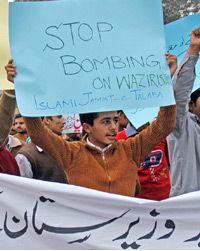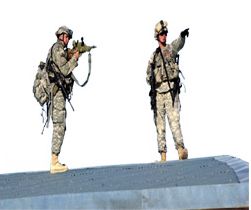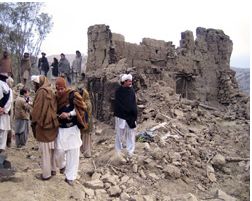Fire on the Frontlines
By Rahimullah Yusufzai | News & Politics | Published 18 years ago
The US, its NATO allies and their common enemy, the Taliban, are all predicting that there will be a significant increase in attacks against the coalition forces, once the extremely cold Afghan winter is out of the way. There is much talk of spring and summer offensives by the Taliban when the weather becomes warmer. All this is generating fear among the Afghans about more bloodshed and, at the same time, causing concern in Islamabad with regard to a possible fallout on Pakistan of the unstable situation in Afghanistan.
This is, more or less, a familiar situation for Pakistan, particularly for its two ‘frontline’ provinces, the NWFP and Balochistan, that have been directly affected by the incessant violence in Afghanistan. For the last 28 years, Pakistan has suffered the consequences of the Afghan conflict in the shape of increasing acts of sabotage and growing militancy, an influx of Afghan refugees, and a proliferation of arms and drugs. There is no light at the end of this long tunnel of agony. More fighting in the coming spring and summer in Afghanistan would translate into greater pressure on Islamabad to pursue military operations againstTaliban and Al Qaeda militants hiding in Pakistan.
The US and its allies are already demanding action on this score, and both Washington and Kabul have made clear their disapproval of the peace agreements that the Pakistan government concluded with homegrown tribal militants in Waziristan. These accords, until now, are still intact, but the recent aerial strikes in North and South Waziristan on suspected militant hideouts led to a tense stand-off between the military and the militants. The Pakistan Army claimed that its own gunship helicopters were used in the attacks rather than the pilotless, US-operated Predator planes, as is widely believed. Baitullah Mahsud, a Taliban commander, threatened to avenge the death of civilians in the airstrikes. And not long after that, there were suicide attacks on soldiers and policemen in and around Waziristan. The collapse of the peace deals would soon return the area to the dangerous situation that haunted Waziristan prior to the accords and possibly trigger a new round of bloodshed.
The US and its NATO allies, together with the beleaguered Afghan government, are gearing up for the expected rise in Taliban attacks during spring. In fact, the usual winter lull in fighting in Afghanistan was often broken by incidents of suicide bombings, ambushes and of military vehicles being blown up by improvised explosive devices (IEDs). The attacks this winter were unusually frequent and more devastating in nature, primarily due to the use of suicide bombings, which, until a few years ago, were unheard of in Afghanistan and Pakistan. It is evident that the Taliban wanted to keep up the pressure on the foreign forces, the Afghan National Army and the Afghan National Police during winter, in order to maintain the tempo of resistance and deny their enemy the space and time to execute reconstruction and development projects in rural Afghanistan, which could win the hearts of the sceptic Pashtun tribes.
 However, the fear of increased attacks may prove to be ill-founded. The Taliban had kept up the pressure even during the winter, by managing to regularly organise suicide bombings and ambushes. US and NATO forces, along with the Afghan troops, were able to inflict significant losses on the Taliban and kill one of their top military commanders, Mulla Akhtar Mohammad Usmani. The Taliban would, thus, not only have to recover from the shock of such setbacks, but also regroup themselves, in order to be able to reinforce their resistance.
However, the fear of increased attacks may prove to be ill-founded. The Taliban had kept up the pressure even during the winter, by managing to regularly organise suicide bombings and ambushes. US and NATO forces, along with the Afghan troops, were able to inflict significant losses on the Taliban and kill one of their top military commanders, Mulla Akhtar Mohammad Usmani. The Taliban would, thus, not only have to recover from the shock of such setbacks, but also regroup themselves, in order to be able to reinforce their resistance.
Meanwhile, coalition forces are not taking any chances. Realising the challenge that their soldiers faced in 2006, when over 4,000 people, including combatants and civilians, were killed, the US-led coalition appears better prepared this year to confront the resistance movement spearheaded by the Taliban. The US took the lead by ordering 3,200 of its soldiers, due to return home after duty, to stay another four months in Afghanistan in a bid to maintain troop levels and augment the NATO forces that fall far short of the required number. The NATO commanders made an appeal for 2,500 additional troops, as well as some jet fighters and gunship helicopters last September, but member countries failed to heed the request. Poland did offer to provide another 1,000 troops, but the deployment was to take place in 2007 and not in late 2006, as NATO desired. Britain, the closest ally of the US in their war on terror, is now considering sending an additional 500 or more soldiers to southern Afghanistan, where up to 5,000 British troops are already battling Taliban fighters, primarily in the Helmand province, and suffering an unexpectedly high number of casualties.
Persistent American and British pressure has forced certain NATO allies like Germany, France, Spain and Italy to lift restrictions on deployment of their troops in active combat zones, such as southern and south-western Afghanistan, during emergencies. Troops from these and some other European countries are deployed in comparatively peaceful parts of Afghanistan in the north and west and have been bitterly criticised as being cowards for performing jobs as traffic-controllers and road-builders, rather than as soldiers. The verbal sparring between NATO partners is damaging for the military alliance when stakes are already high for making a success of NATO’s first combat mission outside Europe.
 While shoring up their defences and providing military teeth to the almost 40,000-strong NATO-led International Security Assistance Force (ISAF), the US and its allies have also been mindful of injecting more money into war-ravaged Afghanistan to undertake reconstruction and accelerate economic activity. The US, once again, took the initiative by sanctioning US$10.6 billion for the country to be spent over the next two years. The European Union (EU) followed suit by announcing a four-year aid package worth US$775 million. The American assistance though, was distributed disproportionately with only US$2 billion set aside for reconstruction, development and drug-eradication projects, and the remaining US$8.6 billion for strengthening Afghanistan’s security forces and police. The EU package was earmarked for upgrading Afghanistan’s archaic judiciary and developing alternative crops to combat the booming narcotics industry. The provision of special funds by the US and EU were a welcome move and a departure from the jingoistic policy they had heretofore followed.
While shoring up their defences and providing military teeth to the almost 40,000-strong NATO-led International Security Assistance Force (ISAF), the US and its allies have also been mindful of injecting more money into war-ravaged Afghanistan to undertake reconstruction and accelerate economic activity. The US, once again, took the initiative by sanctioning US$10.6 billion for the country to be spent over the next two years. The European Union (EU) followed suit by announcing a four-year aid package worth US$775 million. The American assistance though, was distributed disproportionately with only US$2 billion set aside for reconstruction, development and drug-eradication projects, and the remaining US$8.6 billion for strengthening Afghanistan’s security forces and police. The EU package was earmarked for upgrading Afghanistan’s archaic judiciary and developing alternative crops to combat the booming narcotics industry. The provision of special funds by the US and EU were a welcome move and a departure from the jingoistic policy they had heretofore followed.
That policy stressed on achieving an outright military victory over the Taliban, but it failed. Instead, the Taliban emerged with renewed vigour and posed an even greater challenge to the Western forces, after having been considered a spent force five years ago.
With some reluctance, US and NATO military commanders admitted that reconstruction had been slow and the foreign assistance provided to Afghanistan had failed to meet their requirements and was imprudently spent. Also there was acknowledgement that President Hamid Karzai’s regime was inefficient and corrupt, that some government officials and warlords were involved in drug-trafficking and that NATO military operations had killed a disproportionately higher number of civilians. as compared to the combatants.
 However, there was still no admission of the fact that the US-led coalition forces had been high-handed and trigger-happy, and that its bombing campaigns had killed so many innocent people that large sections of the Afghan population felt angry and alienated. Surprisingly, the largely resourceless Taliban showed tremendous resilience against a technologically well equipped and professionally superior enemy.
However, there was still no admission of the fact that the US-led coalition forces had been high-handed and trigger-happy, and that its bombing campaigns had killed so many innocent people that large sections of the Afghan population felt angry and alienated. Surprisingly, the largely resourceless Taliban showed tremendous resilience against a technologically well equipped and professionally superior enemy.
Predictably, Pakistan was blamed for allowing the Taliban and other anti-West elements linked to Al Qaeda and the former Afghan mujahideen leader, Gulbuddin Hekmatyar, to take refuge on its territory and use it to launch attacks across the 2,460 kilometre-long Durand Line into Afghanistan.
There is no denying the fact that some leading Al Qaeda and Taliban figures found refuge in Pakistan in the chaotic situation following the fall of the Taliban in Afghanistan, as a result of the US invasion in late 2001, and that their followers also settled down in the tribal areas straddling the Pak-Afghan border and in Afghan refugee camps and urban settlements. Cross-border infiltration by militants into Afghanistan, too, has not stopped, despite the deployment of 80,000 Pakistani troops at the border and repeated military operations against the local Islamic fighters and their foreign guests.
It was only after losing 700-plus soldiers in the fight against the militants that the Pakistan Army opted to seek an end to the bloodshed in Waziristan through peace treaties with them. President Karzai’s tone, while holding Pakistan responsible for all his troubles, was harsh, and he seemed to have the blessings of the US.
The blame game is expected to become more shrill in the event that the Taliban attacks intensify once the winter season is over. One could also expect cross-border attacks by US and NATO forces in the nature of airstrikes, through the use of Hellfire missiles fired by the CIA-operated drones, inside Pakistan under the principle of “hot pursuit.” Similar tactics have been employed in the past: three houses in Damadola village in Bajaur were bombed on January 13 last year, killing 13 civilians, including women and children. Then, on October 30, a madrassah in Bajaur’s Chingai village was attacked with two missiles, and 80 people, mostly teenaged students, were killed. Contrary to the Pakistan Army’s claim, the general perception was that the airstrikes were carried out in both instances by the American Predators. In fact, residents of villages that were attacked in South Waziristan and North Waziristan earlier are also convinced they were bombed by US missiles and not by Pakistani gunship helicopters, as claimed by the country’s military authorities. Such attacks, whether undertaken by the Pakistan Army or the US military, have provoked the militants to retaliate. The suicide bombing at the Punjab Regiment’s training centre in Dargai, in which 42 recruits were killed, is a case in point. Though no evidence is available so far, it is likely that the spate of recent suicide bombings in the NWFP could also be in retaliation for the airstrikes that targeted militant hideouts in Waziristan.
The situation is fast deteriorating and both Afghanistan and Pakistan are facing destabilisation. The increase in violence in the two countries is contributing to the distrust that has characterised their uneasy ties since the creation of Pakistan in 1947. Such is the extent of the mistrust that Afghanistan’s proposal to hold joint peace jirgas and Pakistan’s move to fence and mine its border with Afghanistan to check cross-border movement of militants has encountered stiff opposition. Given the grim scenario, it is unlikely that the guns will fall silent on Pakistan’s turbulent western border with Afghanistan any time soon.
Rahimullah Yusufzai is a Peshawar-based senior journalist who covers events in the NWFP, FATA, Balochistan and Afghanistan. His work appears in the Pakistani and international media. He has also contributed chapters to books on the region.


